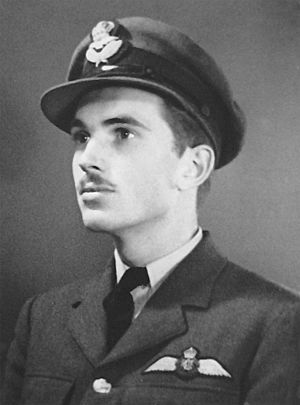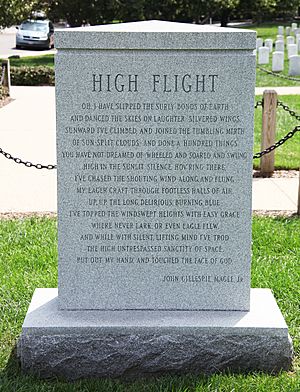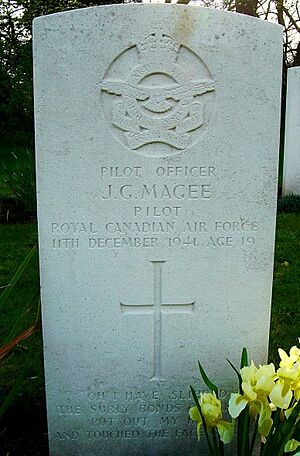John Gillespie Magee Jr. facts for kids
Quick facts for kids
John Gillespie Magee Jr.
|
|
|---|---|

Official Royal Canadian Air Force picture of Pilot Officer John Gillespie Magee Jr.
|
|
| Born | 9 June 1922 Shanghai, Republic of China |
| Died | 11 December 1941 (aged 19) Ruskington, England |
| Place of burial |
Holy Cross Cemetery, Scopwick, England
|
| Service/ |
|
| Years of service | 1940–1941 |
| Rank | Pilot Officer |
| Unit | No. 412 Squadron RCAF |
| Battles/wars | World War II |
John Gillespie Magee Jr. (born June 9, 1922 – died December 11, 1941) was a young World War II pilot and a talented poet. He was an Anglo-American, meaning he had both British and American heritage. He joined the Royal Canadian Air Force (R.C.A.F.) as a fighter pilot and is most famous for writing the poem High Flight. Sadly, he died at just 19 years old in an accidental mid-air collision over England in 1941.
Contents
John Magee's Early Life
- "We laid him in a cool and shadowed grove
- One evening in the dreamy scent of thyme
- Where leaves were green, and whispered high above —
- A grave as humble as it was sublime;
- There, dreaming in the fading deeps of light —
- The hands that thrilled to touch a woman's hair;
- Brown eyes, that loved the Day, and looked on Night,
- A soul that found at last its answered Prayer...
- There daylight, as a dust, slips through the trees.
- And drifting, gilds the fern around his grave —
- Where even now, perhaps, the evening breeze
- Steals shyly past the tomb of him who gave
- New sight to blinded eyes; who sometimes wept —
- A short time dearly loved; and after, — slept."
John Gillespie Magee Jr. was born in Shanghai, China. His father was American and his mother was British. Both of his parents were Anglican missionaries, which means they traveled to spread their Christian faith. His father, John Magee Sr., came from a wealthy family in Pittsburgh, Pennsylvania. He chose to become an Episcopal priest and was sent to China. There, he met Faith Emmeline Backhouse, who was from England and also a missionary. John's parents married in 1921, and he was their first child, born on June 9, 1922. He had three younger brothers.
John started school in Nanking, China, in 1929. In 1931, he moved to England with his mother. He spent four years at St Clare, a preparatory school for boys, in Walmer, Kent. From 1935 to 1939, he attended Rugby School, a famous boarding school. There, he dreamed of becoming a poet and won the school's Poetry Prize in 1938.
He was very inspired by the school's list of students who had died in World War I. This list included the poet Rupert Brooke (1887–1915), whose writing style Magee admired. Brooke had won the same poetry prize 34 years before Magee. Magee's winning poem was about Brooke's burial on the Greek island of Skyros.
While at Rugby, Magee became friends with Elinor Lyon, the headmaster's daughter. She inspired many of his poems.
In 1939, Magee visited the United States. Because World War II had started, he could not return to Rugby for his last school year. Instead, he attended Avon Old Farms School in Connecticut. He earned a scholarship to Yale University in July 1940. However, he decided not to go to Yale. Instead, he chose to volunteer for war service with the Royal Canadian Air Force (R.C.A.F.).
Joining the War Effort
Magee joined the R.C.A.F. in October 1940. He received flight training in Ontario, Canada. He trained at two different airfields: RCAF Station St. Catharines and RCAF Station Uplands. He successfully passed his Wings Test in June 1941. This meant he was ready to become a pilot.
Soon after, he was promoted to the rank of Pilot Officer. He was then sent to the United Kingdom. There, he joined No. 53 Operational Training Unit in RAF Llandow, Wales. His first flight in a Spitfire, a famous British fighter plane, was on August 7, 1941. On August 18, he flew a Spitfire to 33,000 feet (about 10,000 meters). This was his highest flight yet and is believed to have inspired his most famous poem.
After finishing his training, he was assigned to No. 412 (Fighter) Squadron, R.C.A.F.. This was a Canadian unit formed in June 1941. Magee arrived at RAF Digby on September 23, 1941, where he continued to train on the Spitfire. His squadron later switched to a more powerful version of the Spitfire.
On October 20, 1941, Magee took part in a convoy patrol, protecting ships. On the same day, his squadron moved to RAF Wellingore in Lincolnshire, a nearby air station.
First Combat Mission
On November 8, 1941, Magee took part in a mission to Occupied France. His squadron escorted bombers that were attacking railway workshops in Lille. Twelve planes from his squadron flew from Wellingore to RAF West Malling to refuel. Then, they flew over the English Channel.
They crossed the enemy coast near Dunkirk. They faced flak, which are anti-aircraft guns firing at them. Then, they were attacked by Luftwaffe fighters, which were German planes. Of Magee's four-plane section, only he survived. The others were shot down and killed by a leading German ace, Joachim Müncheberg. Magee fired his machine guns but did not claim to have damaged any enemy planes. This was his only combat with the Luftwaffe during the war.
In late November and early December 1941, Magee took part in three more convoy patrols.
A Pilot's Final Flight
On December 11, 1941, Magee was killed. He had been in active service for ten weeks. He was flying his Spitfire (Serial No.AD291), the same plane he had flown in the fight over France. He took off in the late morning with other pilots from his squadron to practice air fighting.
During this practice, Magee's plane collided in mid-air with an Airspeed Oxford trainer plane. The trainer was flown by 19-year-old Ernest Aubrey Griffin. The two planes crashed just below the clouds at about 1,400 feet (427 meters) above the ground. This happened at 11:30 AM over the hamlet of Roxholme, in Lincolnshire. Magee was flying down fast through a break in the clouds with three other Spitfires when his plane hit the Airspeed Oxford.
At the investigation, a local farmer who saw the accident said he saw Magee struggling to open his Spitfire's canopy as it fell out of control. Magee managed to open the canopy and jump out of the plane. However, he was too low for his parachute to open fully. He fell to the ground and died instantly in a field near the village of Ruskington. He was 19 years old. Ernest Aubrey Griffin, the other pilot, also died in the crash.
Magee's body was buried in the graveyard of Holy Cross Church in the village of Scopwick in Lincolnshire. On his gravestone are the first and last lines from his poem High Flight. Part of the official letter sent to his parents said, "Your son's funeral took place at Scopwick Cemetery... He was accorded full Service Honours, the coffin being carried by pilots of his own Squadron."
The Famous Poem: High Flight
"Oh! I have slipped the surly bonds of Earth
And danced the skies on laughter-silvered wings;
Sunward I’ve climbed, and joined the tumbling mirth
of sun-split clouds, — and done a hundred things
You have not dreamed of – wheeled and soared and swung
High in the sunlit silence. Hov’ring there,
I’ve chased the shouting wind along, and flung
My eager craft through footless halls of air....
Up, up the long, delirious, burning blue
I’ve topped the wind-swept heights with easy grace.
Where never lark, or even eagle flew —
And, while with silent, lifting mind I've trod
The high untrespassed sanctity of space,
– Put out my hand, and touched the face of God."
John Magee became famous after his death mainly because of his sonnet High Flight. He started writing it on August 18, 1941, just a few months before he died. He was based at No. 53 OTU at the time. During his seventh flight in a Spitfire, he had flown up to 33,000 feet. As he climbed, he remembered words he had read in another poem: "To touch the face of God." He finished his poem soon after landing.
His fellow Pilot Officer Michael Henry Le Bas was the first person to read Magee's poem that same day. Magee sent the poem in a letter to his parents on September 3, 1941. His father, who was a priest in Washington, D.C., printed it in church newsletters.
The poem became even more widely known thanks to Archibald MacLeish, who was then the Librarian of Congress. He included it in a poetry exhibition called "Faith and Freedom" in February 1942. The original handwritten copy of the poem is still kept at the Library of Congress.
Some phrases in High Flight are similar to lines from other poems written earlier. For example, the last words "...and touched the face of God" can also be found in a poem by Cuthbert Hicks from 1938. Other phrases like "on laughter-silvered wings" and "the lifting mind" also appear in earlier poems by different authors.
How High Flight Has Been Used

High Flight has been a favorite poem for pilots and astronauts. It is the official poem of the Royal Canadian Air Force and the Royal Air Force. Cadets at the United States Air Force Academy must memorize it. Parts of the poem are on many gravestones in the Arlington National Cemetery. The full poem is on the back of the Space Shuttle Challenger Memorial. It is also displayed in museums like the Canadian War Museum and the National Museum of the United States Air Force.
Astronaut Michael Collins took a copy of the poem with him on his Gemini 10 flight. Former NASA Flight Director Gene Kranz quoted the first line in his book Failure Is Not An Option. U.S. President Ronald Reagan used part of High Flight in a speech after the Challenger disaster in January 1986.
The poem has also been used in many other ways:
- Hollywood stars like Merle Oberon recited it to help raise money for the war effort.
- Orson Welles read the poem on radio shows.
- It has been set to music by several composers, including Miklós Rózsa and John Denver.
- Singer Al Jarreau used lines from it in his song "Mornin'".
- It has been referenced in TV shows like Mad Men and Battlestar Galactica.
- The 1993 movie The Man Without a Face features the poem.
- In 2018, Meghan McCain quoted the poem in her speech for her father, John McCain.
Per Ardua
(To those who gave their lives to England during the Battle of
Britain and left such a shining example to us who follow,
these lines are dedicated.)
They that have climbed the white mists of the morning;
They that have soared, before the world's awake,
To herald up their foeman to them, scorning
The thin dawn's rest their weary folk might take;
Some that have left other mouths to tell the story
Of high, blue battle, quite young limbs that bled,
How they had thundered up the clouds to glory,
Or fallen to an English field stained red.
Because my faltering feet would fail I find them
Laughing beside me, steadying the hand
That seeks their deadly courage –
Yet behind them
The cold light dies in that once brilliant Land ....
Do these, who help the quickened pulse run slowly,
Whose stern, remembered image cools the brow,
Till the far dawn of Victory, know only
Night's darkness, and Valhalla's silence now?
Shortly after his first combat mission on November 8, 1941, Magee sent his family part of another poem. He called it "another trifle which may interest you." This poem, Per Ardua, might be the last one Magee wrote. There are some corrections in the poem made by Magee, which suggests he had not finished it when he sent it. Per ardua ad astra ("Through adversity to the stars") is the motto of several air forces, including the Royal Air Force and the Royal Canadian Air Force.
Images for kids




